|

Here you'll find articles about museums that feature exhibitions on
antiques and collectibles.
LATEST MUSEUM__________________________________________
The Sacred Art of
Glencairn
by Bob
Brooke
Raymond Pitcairn had a
vision—to build a castle-like mansion high on a hill north of
Philadelphia in Bryn Athyn, Pennsylvania. Here, he and his wife could
raise their family, and he would have a place to house his art
collections.

 Pitcairn’s
parents took him abroad regularly from the age of three, and during
these visits they took trips to the great cathedrals and art museums of
Europe. These experiences made a deep impression on the boy, who in time
developed a passion for medieval architecture. Pitcairn’s
parents took him abroad regularly from the age of three, and during
these visits they took trips to the great cathedrals and art museums of
Europe. These experiences made a deep impression on the boy, who in time
developed a passion for medieval architecture.
Pitcairn began collecting medieval art in 1916, originally to provide
inspirational examples for the craftsmen producing stained glass windows
and sculptures for the new cathedral. Although his interest lay more in
architecture than art collecting, by 1922 the size of the collection had
outgrown Pitcairn’s home, Cairnwood, and Pitcairn began planning a new
building which he called Glencairn. Over the next few years, his initial
concept of a "cloister studio" developed into a plan for a
Romanesque-style “castle,” located on a flat piece of ground adjacent to
Cairnwood.
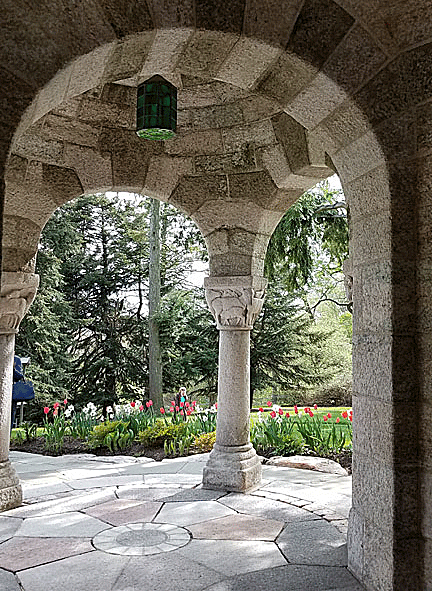 Pitcairn
and his design team carefully planned how to incorporate his favorite
works of art into the structure of the building. He had a scale model of
Glencairn's great hall made so that objects could be tested in a variety
of locations until they seemed to be in harmony with their new
surroundings. After many years of design and construction, the Pitcairns,
moved into Glencairn, their new home, in 1939. Pitcairn
and his design team carefully planned how to incorporate his favorite
works of art into the structure of the building. He had a scale model of
Glencairn's great hall made so that objects could be tested in a variety
of locations until they seemed to be in harmony with their new
surroundings. After many years of design and construction, the Pitcairns,
moved into Glencairn, their new home, in 1939.
Pitcairn built Glencairn in a style based on medieval Romanesque
architecture, but incorporated elements of medieval Gothic buildings in
it as well. The design of the building evolved gradually, using scale
and full-sized models rather than relying exclusively on predetermined
architectural plans.
The work of George Grey Barnard, the American sculptor and medieval art
collector who in 1914 opened his
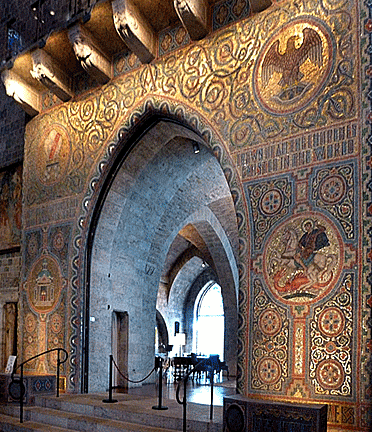 Cloisters
Museum in upper Manhattan, greatly influenced the design of Glencairn.
It was here that Pitcairn saw how Barnard had incorporated art into the
interior of his museum. Cloisters
Museum in upper Manhattan, greatly influenced the design of Glencairn.
It was here that Pitcairn saw how Barnard had incorporated art into the
interior of his museum.
As with Bryn Athyn
Cathedral, Pitcairn insisted that all the elements of Glencairn be
produced on site in workshops originally built for artisans who worked
on the cathedral. Artisans produced intricate mosaic designs based on
the Book of Kells, a medieval manuscript written about 800 A.D., for the
ceiling trusses in the Great Hall and featuring quotations from the
theological works of Swedenborg.
Many of the walls and
ceilings in Glencairn are decorated with intricate glass mosaics,
designed and produced in the Bryn Athyn glass studio and factory. A
great deal of experimentation was needed to recreate the visual effect
of 5th-century Byzantine mosaics, which Raymond Pitcairn regarded as the
highest form of the art. Gold mosaic is made by encasing a sheet of gold
leaf between two layers of glass. Individual pieces of mosaic tesserae
are cut using a special hammer.
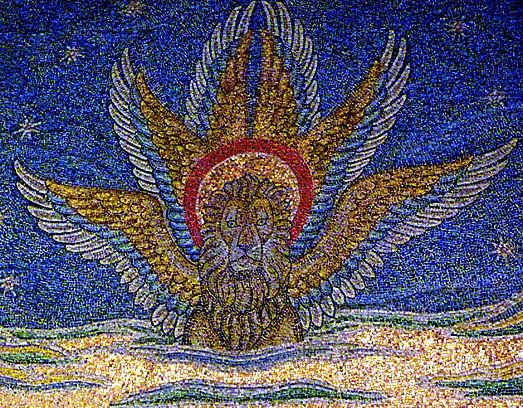
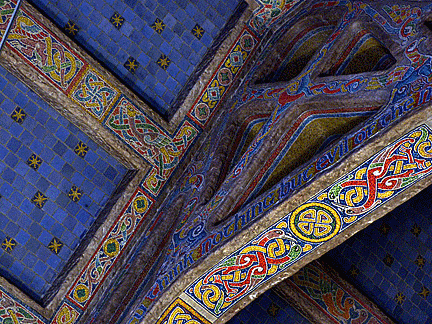 To
support the weight of Glencairn's roof, which is made of poured
concrete, the ceiling was spanned with large steel trusses, which were
then covered with mosaic. Robert Glenn and Winfred S. Hyatt produced
designs for Glencairn’s mosaics. Once a design was completed, it was
transferred to a sheet of heavy paper and the individual pieces of
mosaic tesserae were glued to it. The mosaic sheets were then pressed
into wet cement, the paper and glue washed away, and the tesserae was
then grouted. A craftsmen prepares yellow mosaic stars for the blue
ceiling of the great hall. To
support the weight of Glencairn's roof, which is made of poured
concrete, the ceiling was spanned with large steel trusses, which were
then covered with mosaic. Robert Glenn and Winfred S. Hyatt produced
designs for Glencairn’s mosaics. Once a design was completed, it was
transferred to a sheet of heavy paper and the individual pieces of
mosaic tesserae were glued to it. The mosaic sheets were then pressed
into wet cement, the paper and glue washed away, and the tesserae was
then grouted. A craftsmen prepares yellow mosaic stars for the blue
ceiling of the great hall.
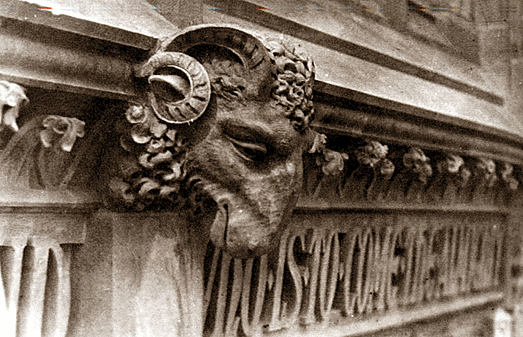
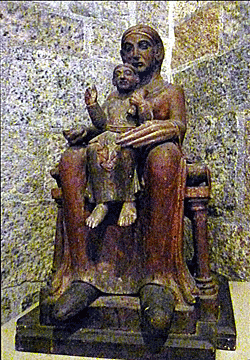 According
to Pitcairn, "The effect of this rich blue ground with the gold stirs
set off, or framed, by mosaic covered beams done in rich color is really
thrilling." According
to Pitcairn, "The effect of this rich blue ground with the gold stirs
set off, or framed, by mosaic covered beams done in rich color is really
thrilling."
Though Pitcairn built Glencairn as a home for his family, he designed
the Great Hall to display an art collection, but above all else he
intended Glencairn to be a home. In addition to medieval art, Glencairn
contains a wealth of original art in stone, wood, glass, and mosaic
created by Bryn Athyn craftsmen and inspired by New Church beliefs.
The major decorative themes are variations of one of the Bible's most
repeated commands, "You shall love your neighbor as yourself." Symbols
of the four communities the Pitcairns hoped to serve during their
lifetimes—family, school, country, and church— can he found throughout
the building.
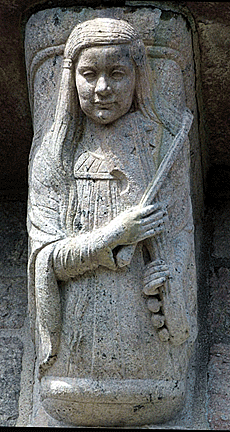 The
theme of family appears many times in the decoration of Glencairn,
usually represented by sheep and lambs. The
theme of family appears many times in the decoration of Glencairn,
usually represented by sheep and lambs.
Music was an important part of the life of the Pitcairn family. Pitcairn
had images of his children with their musical instruments carved on
large corbels supporting a balcony on the south wall of Glencairn's
tower.
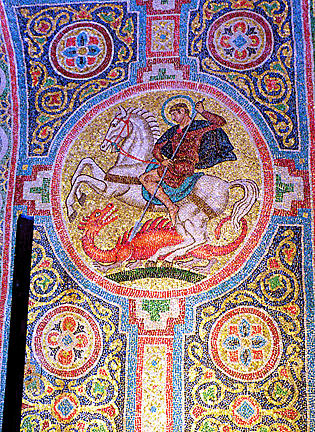 Other
quotes from New Church teachings appear all over the house. Pitcairn
designed the monumental arch covered in glass mosaic which extends up to
the third-floor balcony of the Great Hall. The subject of the mosaic is
the school seal, which consists of four medallions surmounted by a
crowned seated lion. Each medallion represents one of the tour schools
of the Academy of the New Church—the Boy’s School, the Girls School,
Bryn Athyn College, and the Theological School. Other
quotes from New Church teachings appear all over the house. Pitcairn
designed the monumental arch covered in glass mosaic which extends up to
the third-floor balcony of the Great Hall. The subject of the mosaic is
the school seal, which consists of four medallions surmounted by a
crowned seated lion. Each medallion represents one of the tour schools
of the Academy of the New Church—the Boy’s School, the Girls School,
Bryn Athyn College, and the Theological School.
In addition to Christian art, Raymond Pitcairn acquired art from ancient
Egypt, the Ancient Near East, ancient Greece and Rome, and a few objects
from Asian and Islamic cultures, all related to the religion of each
culture. The jewel of his collection of medieval stained glass is a
colorful 13th-century panel depicting a king from the Tree of Jesse
Window at Soissons Cathedral in France. The subject is the royal
genealogy of Jesus Christ.
Visitors begin their tour of Glencairn in the Great Hall. After viewing
the medieval statuary, tapestries, mosaics, and stained glass windows
there, they move up to the top of the tower by elevator for a panoramic
view of Bryn Athyn. From there, they work their way down by stairs floor
by floor, viewing galleries along the way.
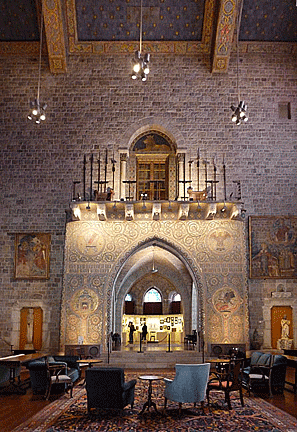
The first is the family chapel on the fifth floor, with its beautiful
stained glass windows.

The decorative art work on the stairway is stylized Egyptian and Islamic
motifs. As they enter the chapel, they’re immediately drawn to the
stained glass windows on either side, one showing the Christmas story
and the other the Easter story. Then they gaze upwards to the mosaic
ceiling.
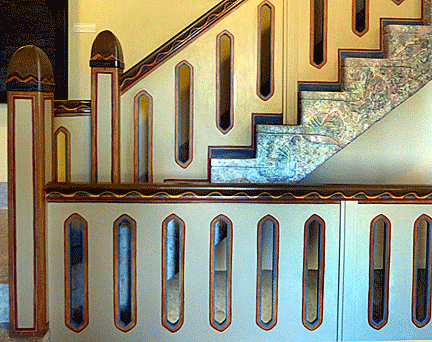
 On
the floor below is the Egyptian Gallery in what once was the bedroom of
one of Pitcairn’s daughters. Pitcairn organized the objects in
Glencairn's Egyptian Gallery around religious themes like Egyptian gods,
mythology, and mummification. Miniaturized dioramas illustrate Egyptian
beliefs about the afterlife. One diorama, The Embalmer's Art: Mummy,
Myth, Magic, shows a large embalmer's workshop at the end of the New
Kingdom. Mummification was primarily a religious ritual that re-enacted
the myth of Osiris, a legendary king who his brother Seth murdered and
dismembered. Osiris was later re-assembled, wrapped with bandages, and
magically revived to become the ruler of the dead. Similarly, each
Egyptian man and woman hoped to become an "Osiris" in the next life
through the process of mummification. A highlight of this gallery is a
handpainted cover for a mummy. On
the floor below is the Egyptian Gallery in what once was the bedroom of
one of Pitcairn’s daughters. Pitcairn organized the objects in
Glencairn's Egyptian Gallery around religious themes like Egyptian gods,
mythology, and mummification. Miniaturized dioramas illustrate Egyptian
beliefs about the afterlife. One diorama, The Embalmer's Art: Mummy,
Myth, Magic, shows a large embalmer's workshop at the end of the New
Kingdom. Mummification was primarily a religious ritual that re-enacted
the myth of Osiris, a legendary king who his brother Seth murdered and
dismembered. Osiris was later re-assembled, wrapped with bandages, and
magically revived to become the ruler of the dead. Similarly, each
Egyptian man and woman hoped to become an "Osiris" in the next life
through the process of mummification. A highlight of this gallery is a
handpainted cover for a mummy.
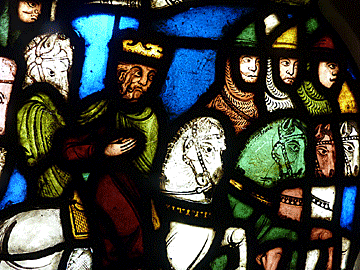 As
visitors enter the smaller of the medieval galleries, a former bedroom
of one of Pitcairn’s sons, they immediately notice the brilliance of the
authentic French stained glass embedded into the far wall. The pieces
came from the Abby of St. Denis and include “The Flight into Egypt” and
a king with soldiers on horseback. The centerpiece of the Medieval
Gallery is a carved 15th-century choir stall from coastal Spain. Over
600 pieces of medieval art make up the largest and most important
collection in Glencairn. It consists of mostly French sculpture and
stained glass from the years 1100 to1300. There are also ivories,
enamels, manuscripts, tapestries and frescos. Besides two medieval
galleries, Glencairn has many works of medieval art installed in the
Great Hall. As
visitors enter the smaller of the medieval galleries, a former bedroom
of one of Pitcairn’s sons, they immediately notice the brilliance of the
authentic French stained glass embedded into the far wall. The pieces
came from the Abby of St. Denis and include “The Flight into Egypt” and
a king with soldiers on horseback. The centerpiece of the Medieval
Gallery is a carved 15th-century choir stall from coastal Spain. Over
600 pieces of medieval art make up the largest and most important
collection in Glencairn. It consists of mostly French sculpture and
stained glass from the years 1100 to1300. There are also ivories,
enamels, manuscripts, tapestries and frescos. Besides two medieval
galleries, Glencairn has many works of medieval art installed in the
Great Hall.
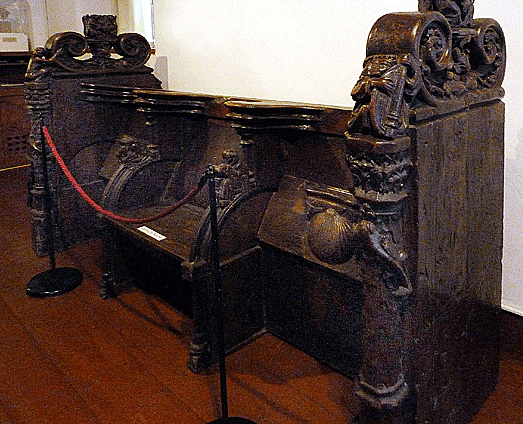
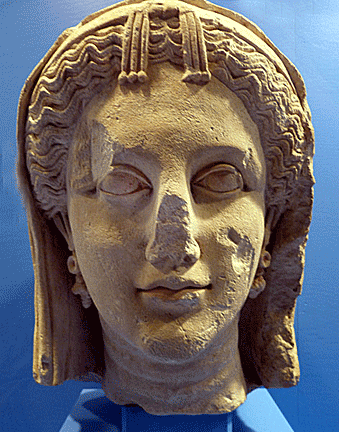 Glencairn
has two classical galleries, one for Roman and the other for Greek
antiquities, together showcasing some of the collection’s 500 ancient
artifacts. The most spectacular piece is a nearly life-sized marble
statue of Minerva Victoria, an eye-catching and well-preserved Roman
statue of the goddess Minerva in the guise of Victory from Cyrene in
modern-day Libya. Glencairn
has two classical galleries, one for Roman and the other for Greek
antiquities, together showcasing some of the collection’s 500 ancient
artifacts. The most spectacular piece is a nearly life-sized marble
statue of Minerva Victoria, an eye-catching and well-preserved Roman
statue of the goddess Minerva in the guise of Victory from Cyrene in
modern-day Libya.
Visitors also visit the library with its massive vaulted beam ceiling.
Adjacent to the library is the master bedroom, left as the Pitcairns had
used it with its handcarved bed.

Glencairn's American Indian Gallery includes artifacts from tribes in
Mesoamerica, the Northwest, the Southwest, the Plains, the Eastern
Woodlands, and the Inuit areas. Though the oldest pieces date from 3,000
to 1,000 BCE, most date from the late 19th and early 20th centuries.
While several objects have special religious significance, many of the
common objects on display illustrate the way that religion permeated the
lives of Native Americans.
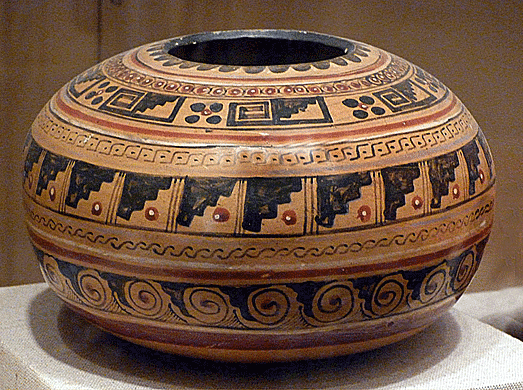
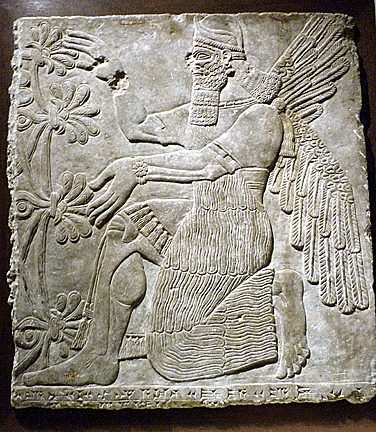 The
Ancient Near East collection contains artifacts of significance to the
history of religion. Smaller pieces include cuneiform tablets, cylinder
seals with images of deities, and votive objects dedicated at shrines
and temples. The cuneiform tablets, foundation cones, and a large
foundation cylinder describing the rebuilding of the walls of Babylon by
Nebuchadnezzar are just some of the important items. The
Ancient Near East collection contains artifacts of significance to the
history of religion. Smaller pieces include cuneiform tablets, cylinder
seals with images of deities, and votive objects dedicated at shrines
and temples. The cuneiform tablets, foundation cones, and a large
foundation cylinder describing the rebuilding of the walls of Babylon by
Nebuchadnezzar are just some of the important items.
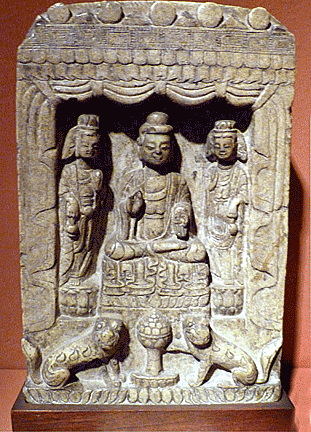 The
museum’s Asian collection features 30 works of art from China, with a
few from Japan and Thailand. Ranging from the Chinese Han Dynasty from
25-220 A.D. to the 19th century, the objects reflect the beliefs and
values of East Asian Mahayana Buddhism as well as elements of
traditional Chinese culture with its Confucian and Taoist influences. A
highlight of the gallery is a large Chinese bronze sculpture of a seated
Taoist sage from the Ming Dynasty, dating from 1368-1644 A.D., who has
understands the operation of the Tao, meaning "the Way," as it appears
in nature, then incorporates this into his life. The
museum’s Asian collection features 30 works of art from China, with a
few from Japan and Thailand. Ranging from the Chinese Han Dynasty from
25-220 A.D. to the 19th century, the objects reflect the beliefs and
values of East Asian Mahayana Buddhism as well as elements of
traditional Chinese culture with its Confucian and Taoist influences. A
highlight of the gallery is a large Chinese bronze sculpture of a seated
Taoist sage from the Ming Dynasty, dating from 1368-1644 A.D., who has
understands the operation of the Tao, meaning "the Way," as it appears
in nature, then incorporates this into his life.
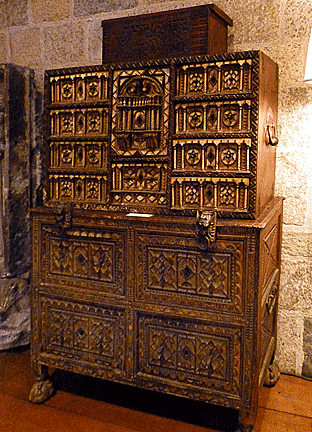 Raymond
Pitcairn collected mostly European furniture, including Windsor chairs,
tables, storage chests, and desks which sit in prominent places
throughout the museum. In addition, Glencairn contains over 200 antique
oriental rugs, including village and tribal rugs, as well as prayer
rugs. The decoration of prayer rugs is rich in Islamic symbolism,
including symbols from religions that existed in the ancient Near East
before Islam. The "mihrab" is an arch that points toward the Holy City
of Mecca. Both the rug and the worshiper praying on it are required to
point toward Mecca. In Islamic tradition this arch represents the
"gateway to paradise." The symbol of an arch as a gateway to paradise
has its origin in ancient Mesopotamian symbolism, which predates Islam
by several millennia. Raymond
Pitcairn collected mostly European furniture, including Windsor chairs,
tables, storage chests, and desks which sit in prominent places
throughout the museum. In addition, Glencairn contains over 200 antique
oriental rugs, including village and tribal rugs, as well as prayer
rugs. The decoration of prayer rugs is rich in Islamic symbolism,
including symbols from religions that existed in the ancient Near East
before Islam. The "mihrab" is an arch that points toward the Holy City
of Mecca. Both the rug and the worshiper praying on it are required to
point toward Mecca. In Islamic tradition this arch represents the
"gateway to paradise." The symbol of an arch as a gateway to paradise
has its origin in ancient Mesopotamian symbolism, which predates Islam
by several millennia.
Only a portion of the galleries are regularly open to the public by
conducted tour, but the museum sponsors two weekend-long festivals, a
spiritual arts festival in April and a medieval festival in November, at
which time all the galleries are open.
<
Back to
More Antiques to View
|
